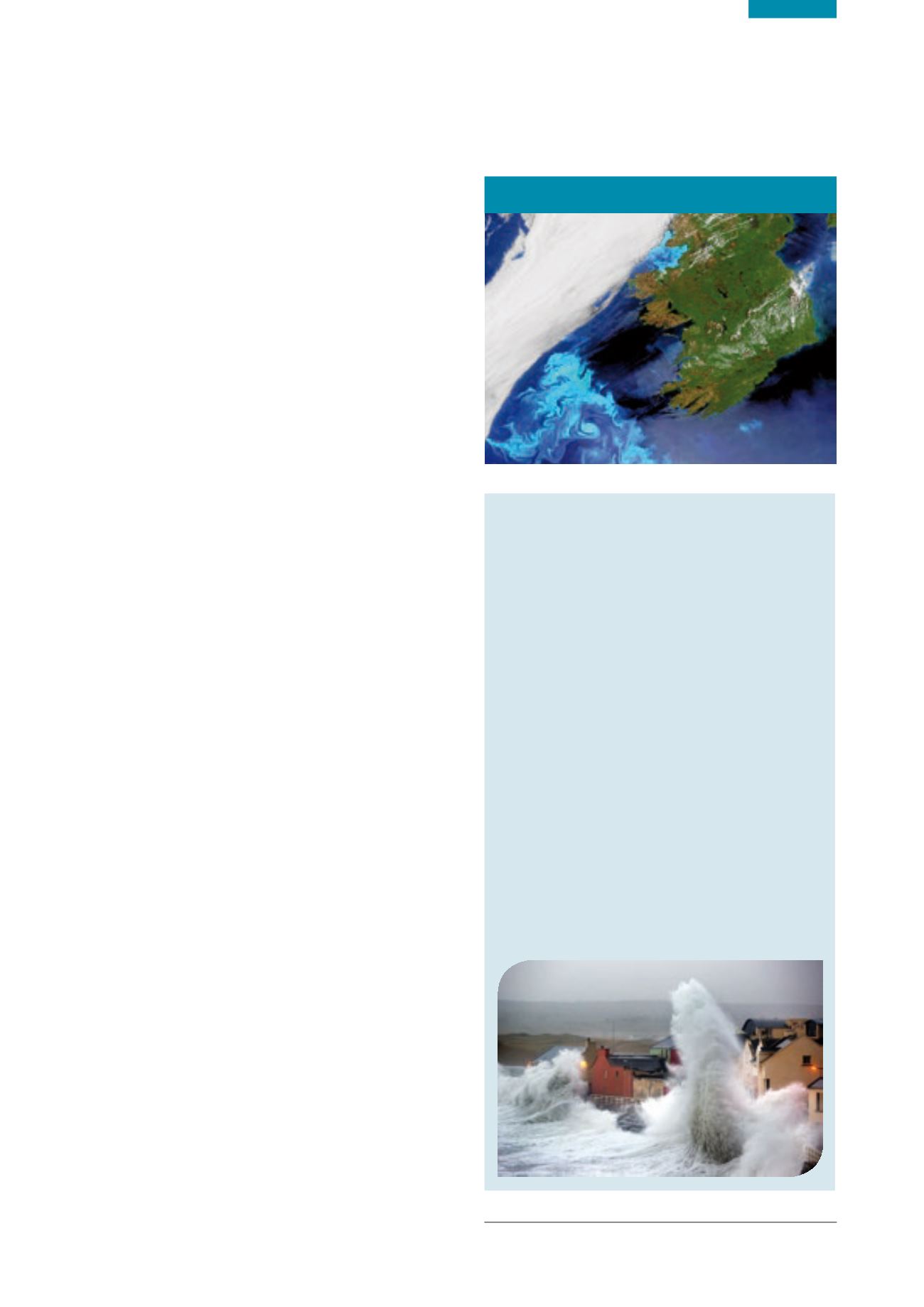

83
Chapter 5: Inland and Marine Waters
Impacts of Climate Change on the Water
Environment
Rising sea temperatures, ocean acidification, ocean
deoxygenation and rising sea levels have been
identified as four of the key stressors impacting on
the world’s oceans and coastal environments.
The key impacts of climate change for Ireland are
described in Chapter 3. With regard to inland water
ecosystems, the most obvious and direct impacts predicted
include changes in river flows. Robust increases are
expected in winter and spring, in the order of 20% in
winter by the mid to late twenty-first century, while
reductions in the summer and autumn months of over
40% are likely in many catchments. Flood events are likely
to become more frequent with extreme flood events,
currently expected once in every 50 years, likely to occur
once every 10 years by the second half of this century
(Murphy and Fealy, 2010; Coll and Sweeney, 2013).
With regard to marine waters, rising sea temperatures,
ocean acidification, ocean deoxygenation and rising sea
levels have been identified as four of the key stressors
impacting on the state of the world’s oceans and
coastal environments (EPA, 2003; Devoy, 2008; Diaz and
Rosenberg, 2008; O’Boyle
et al
., 2009, 2013; Gruber,
2011; Dwyer, 2012; Duarte
et al
., 2013; IPPC, 2013;
Bates
et al
., 2014; ICES, 2014; Wallace
et al
., 2014;
Bradley
et al
., 2015; McGrath
et al
., 2015).
Coastal erosion along the Atlantic coast of Europe was
particularly severe and extensive during the 2013/2014
winter period owing to extreme storm conditions. Storms
of this severity had not been experienced since 1948
(Masselink
et al
., 2016). These factors have the potential
to seriously affect the functioning of marine and coastal
ecosystems, and Irish waters are not immune from these
global effects. Increases in water temperature have
already been observed and, although these are partially
attributable to natural cycles, the rate of change is of
concern. Ocean acidification effects are being observed
in our offshore surface waters (ICES, 2014) and these
changes in ocean chemistry could potentially be very
damaging to marine organisms, particularly to those with
carbonaceous structures, such as corals, crustaceans,
certain species of plankton and seaweeds, such as the
coccolithophorids, which often bloom in Irish waters
(Figure 5.14). The milky turquoise swirls off the south and
west coasts of Ireland, visible from space, are made up of a
large bloom of phytoplankton. These harmless microscopic
plants are members of a group of plankton known as
‘coccolithophorids’. Each tiny cell is covered in chalky plates
and when the conditions are favourable the large blooms
of these species turn the sea a milky white colour. These
blooms are part of the natural marine food web but are
susceptible to environmental disturbance such as ocean
acidification.
Figure 5.14
Coccolithophorid bloom
22
(Source: © ESA)
Impacts of Climate Change in the
Marine Environment
The example of Coastal Erosion
Masselink
et al
. (2016) reported that studies of coastal
vulnerability due to climate change tend to focus on
the consequences of sea-level rise, rather than on the
complex coastal responses resulting from changes
to the extreme wave climate. The 2013/2014 winter
wave conditions that severely affected the Atlantic
coast of Europe were investigated and it was found
that this winter was the most energetic along most
of the Atlantic coast of Europe since at least 1948.
Along exposed open-coast sites, extensive beach
and dune erosion occurred as a result of offshore
sediment transport. More sheltered sites experienced
less erosion, and one of the sites even experienced
accretion as a result of beach rotation induced
by alongshore sediment transport. Storm wave
conditions such as were encountered during the
2013/2014 winter have the potential to dramatically
change the equilibrium state (beach gradient, coastal
alignment and nearshore bar position) of beaches
along the Atlantic coast of Europe.
22
www.esa.int/var/esa/storage/images/esa_multimedia/images/2012/10/ algal_bloom_off_ireland/11888154-3-eng-GB/Algal_bloom_off_Ireland.tif

















